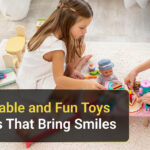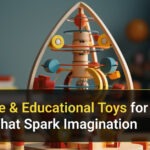By the time children reach the early school years, around ages 6 to 8, they’ve developed a new level of curiosity and independence. They’re asking more complex questions, understanding how things work, and beginning to form deeper interests in subjects like art, science, and sports. The right toys during this stage can do more than entertain; they can inspire imagination, strengthen critical thinking, and reinforce what they’re learning in school.
Choosing toys for 6 year olds requires balancing fun and education. Kids this age still love to play, but they’re also ready for challenges that spark creativity, logic, and social skills. In this blog, we’ll explore what makes the best toys for early school-age children, how play influences their development, and which types of toys bring out the best in their growing minds.
Understanding the 6–8 Age Group
Early school-age children experience tremendous growth, physically, cognitively, and emotionally. They’re mastering reading, writing, and basic math, while also developing social awareness and self-control.
At this stage, play continues to be an essential learning tool. It helps children apply what they learn in the classroom to real-world situations. Toys that stimulate imagination, problem-solving, and teamwork not only support their education but also build confidence and resilience.
When selecting toys for 6 year olds, it’s important to remember that they’re transitioning from simple pretend play to more complex, goal-oriented activities. They want to build, create, and experiment, while also having fun.
What to Look for in Toys for Early School Age
Before diving into recommendations, it helps to understand the traits that make toys valuable for this age group. A well-chosen toy should:
- Encourage Active Learning: Toys that involve thinking, experimenting, or building keep young minds engaged.
- Promote Creativity: Art, crafts, and construction sets inspire imagination and originality.
- Support Physical Development: Outdoor or movement-based toys build coordination and strength.
- Foster Social Skills: Board games and cooperative play sets teach teamwork and empathy.
- Be Safe and Durable: Kids at this age can be energetic; toys should withstand frequent use and rough handling.
The best toys are those that grow with the child, offering new levels of challenge and excitement as their skills evolve.
1. Building and Construction Sets
Children in this age range love to create and design. Building sets, like LEGO®, magnetic tiles, or wooden blocks, help develop spatial awareness, problem-solving, and fine motor skills.
When kids design towers, vehicles, or entire cities, they’re not just stacking bricks—they’re planning, experimenting, and learning how different shapes fit together. Construction play also nurtures patience and perseverance, teaching valuable lessons about trial and error.
Many of these sets now incorporate STEM concepts, helping kids grasp engineering and architecture basics in a hands-on way. That’s what makes them some of the most rewarding toys for 6 year olds; they combine play with purpose.
2. STEM and Educational Toys
As children enter school, their curiosity about how things work reaches new heights. STEM (Science, Technology, Engineering, and Math) toys are ideal for fueling this curiosity.
From beginner coding kits to simple robotics sets, STEM toys introduce complex ideas through play. They encourage experimentation, critical thinking, and logical reasoning. Science kits that involve mixing safe chemicals, building circuits, or exploring magnetism allow children to learn by doing.
For example, a child who builds a small robot learns not just about mechanics but also problem-solving and persistence. These experiences help connect classroom concepts with real-world applications, making STEM kits among the most powerful toys for 6 year olds today.
3. Creative Arts and Crafts
At ages 6 to 8, imagination flourishes. Many children love drawing, painting, or crafting, and art supplies allow them to express their growing creativity.
Art kits with colored pencils, watercolors, or clay help improve fine motor control while fostering emotional expression. Craft-based toys, like bead jewelry sets, DIY slime kits, or paper model projects, encourage focus and creativity while giving kids a sense of accomplishment.
Art also helps children relax and process emotions. After a long day of schoolwork, creative play can be a healthy, rewarding outlet. Among all toys, art sets stand out for supporting both skill development and emotional growth.
4. Board Games and Puzzles
Board games are more than just fun; they teach strategy, patience, and social skills. Games like UNO, Scrabble Junior, or Guess Who? encourage problem-solving and communication while providing hours of family bonding.
Puzzles, on the other hand, challenge children’s spatial reasoning and concentration. Assembling a 100-piece puzzle or solving a 3D maze strengthens attention span and persistence.
These activities also promote teamwork and healthy competition, two essential skills for both school and life. Many parents find that incorporating board games into family nights creates meaningful memories while reinforcing the value of shared learning for 6-year-olds.
5. Outdoor and Sports Toys
Physical activity is crucial for growing bodies. Outdoor toys like scooters, jump ropes, balance bikes, and sports sets not only keep kids active but also teach coordination, balance, and teamwork.
For example, a simple basketball hoop can improve focus and motor control, while a soccer ball encourages group play and strategic thinking. Trampolines or obstacle courses offer fun challenges that boost endurance and confidence.
Outdoor toys for 6 year olds also promote independence, helping children explore, take small risks, and build resilience. Fresh air and unstructured outdoor play are vital for both physical and mental health.
6. Pretend Play and Role-Playing Sets
While younger children engage in simple make-believe, school-aged kids start adding storylines and structure to their pretend play. They might role-play as teachers, doctors, astronauts, or chefs, integrating what they learn in school into imaginative scenarios.
Playsets like dollhouses, doctor kits, or play kitchens foster empathy and creativity. They help children understand real-world roles and develop social awareness. Role-playing also enhances communication skills and encourages cooperative play among friends or siblings.
In short, pretend play remains a cornerstone of development even at this stage, making role-based sets some of the most meaningful toys available.
7. Musical Instruments
Music stimulates multiple areas of the brain, improving memory, coordination, and emotional expression. Introducing kids to basic instruments, such as a keyboard, ukulele, or drum set, can spark a lifelong love of music.
Learning simple rhythms or melodies builds confidence and discipline. Even toy versions of instruments provide valuable sensory and cognitive benefits. Children who engage in musical play often show improved focus and creativity in other areas of learning.
When choosing musical toys for 6 year olds, look for durable instruments designed for small hands and beginner-friendly lessons that keep them motivated.
8. Reading and Storytelling Toys
As literacy skills develop, many children discover the joy of reading. Storytelling toys and interactive books nurture imagination and comprehension.
Audio storybooks, word-building games, and magnetic alphabet sets help children expand their vocabulary and language skills. Reading-based play not only strengthens academic performance but also builds empathy as kids explore different characters and situations.
Parents can encourage reading by setting up a cozy corner with books, storytelling puppets, or educational tablets loaded with story apps. These are among the toys that seamlessly blend entertainment with learning.
9. Collectible and Challenge-Based Toys
Many children between 6 and 8 start developing specific interests, whether it’s superheroes, dinosaurs, or fantasy creatures. Collectible toys, such as action figures or trading cards, allow them to express individuality and build collections that spark pride and social connection.
Similarly, challenge-based toys like brain teasers, logic puzzles, or building kits with specific goals can keep curious minds engaged for hours. They promote persistence and critical thinking, qualities that translate into academic success.
Choosing collectibles or brain games tailored to a child’s interests keeps playtime exciting while nurturing intellectual growth. These personalized experiences make such items standout toys for 6 year olds in any collection.
10. Technology and Interactive Learning
Technology can be a powerful educational ally when used thoughtfully. Interactive learning tablets, coding robots, and educational apps introduce kids to digital literacy in a safe, age-appropriate way.
Devices that teach spelling, math, or creative design can complement school learning while keeping kids entertained. However, balance is essential, screen time should be limited, and hands-on play should always remain a priority.
When guided properly, interactive tech can become one of the most effective toys, fostering innovation and confidence in using technology responsibly.
How Play Shapes Emotional and Social Growth
Toys do more than teach academic or physical skills, they shape emotional intelligence. Through cooperative play, kids learn empathy, patience, and sharing. Group games encourage communication and help children navigate friendship dynamics.
Play also builds self-esteem. When a child completes a puzzle, creates artwork, or wins a small challenge, they experience a sense of accomplishment. This confidence carries over into the classroom and daily life, fostering resilience and a positive self-image.
The best toys for 6 year olds are those that combine learning, emotional development, and pure joy, reminding us that play is still the most powerful teacher.
Tips for Parents When Choosing Toys
When shopping for toys, parents should focus on quality, purpose, and variety. Here are some practical tips:
- Choose toys that align with your child’s interests but also introduce new experiences.
- Mix individual and group play options to promote both independence and cooperation.
- Avoid overly complex or screen-heavy toys that limit imagination.
- Rotate toys every few weeks to maintain engagement and excitement.
- Encourage playtime that involves problem-solving, storytelling, or creativity.
The goal is not to fill shelves but to select toys that enrich your child’s development in meaningful ways.
Final Thoughts
The early school years are a fascinating time of exploration and discovery. Children between 6 and 8 are eager to learn, experiment, and challenge themselves. The right toys can help channel that energy into growth physically, intellectually, and emotionally.
The best toys for 6 year olds strike a balance between fun and education. They nurture creativity, curiosity, and confidence while helping children make sense of the world around them.
Whether it’s a building set that teaches problem-solving, a science kit that sparks curiosity, or a board game that strengthens social skills, every toy can contribute to learning in its own unique way.
In the end, play is still the most natural form of education. By choosing toys that inspire both heart and mind, parents can ensure their children grow into imaginative, capable, and happy learners, ready to take on whatever challenges come next.






